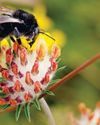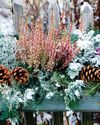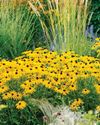
ARCHITECTURAL plants have flowers or foliage with strong, sharp, or dramatic shapes. Garden designers use them to add interest and theatrical structure; their bold forms act as foils for softer plants, as well as creating visual accents that draw the eye and make a garden more captivating. And architectural perennials can be planted now.
Some are dramatic giants that live at the back of the border. For instance, the 2m-tall Eryngium pandanifolium ‘Physic Purple’, which has sprays of dark-red cone flowers above a mass of spear-like foliage. And the waterside giant Gunnera manicata, which grows into a mound of dinosaur-sized leaves every single year.
Other architectural perennials are more compact. The yellow candles of Kniphofia ‘Bees’ Lemon’ and the sword leaves of Crocosmia ‘Lucifer’ grow to 39in (1m) tall, while the immense firework heads of Allium schubertii and the heartshaped leaves of Hosta ‘Francee’ only reach 60cm. And tiny houseleeks (Sempervivum) are some of the most architectural plants in the garden.
Positioning and perspective
But size doesn’t matter if plants don’t block the view. Digitalis parviflora ‘Milk Chocolate’, for instance, forms slender 24in (60cm) spikes of amber-fawn flowers, and looks great near the front of the border because the plants behind can be seen. Likewise, the drumsticks of Allium sphaerocephalon act as accents that draw the eye and allow a view of the plants beyond, in turn creating layers.
This story is from the March 27, 2021 edition of Amateur Gardening.
Start your 7-day Magzter GOLD free trial to access thousands of curated premium stories, and 8,500+ magazines and newspapers.
Already a subscriber ? Sign In
This story is from the March 27, 2021 edition of Amateur Gardening.
Start your 7-day Magzter GOLD free trial to access thousands of curated premium stories, and 8,500+ magazines and newspapers.
Already a subscriber? Sign In

To dig or not to dig?
Should we be carrying out a full dig on plots now? Bob considers the pros and cons of the 'autumn dig' debate

The box ball blues
As if his beleaguered box hadn't already taken a beating, Toby now has to deal with some hungry box caterpillars

Save your own seeds
Masterclass on: seed saving

Strange sightings
Three unusual insects turn up in Val's garden in one day

A bolt from the blue!
Cornflowers are perfect for garden and vase

Winter moth prevention
Ruth shows you how to avoid maggoty tree fruits

Create a winter container
There are as many options as in summer

Lightweight gardening tools
AS well as being good for our mental health, gardening is also great exercise.

Autumn price round-up
AG finds better bargains in lesser-known brands

Rudbeckias
Rudbeckias are ideal for sunny summer patios and borders, with some able to survive our coldest winters